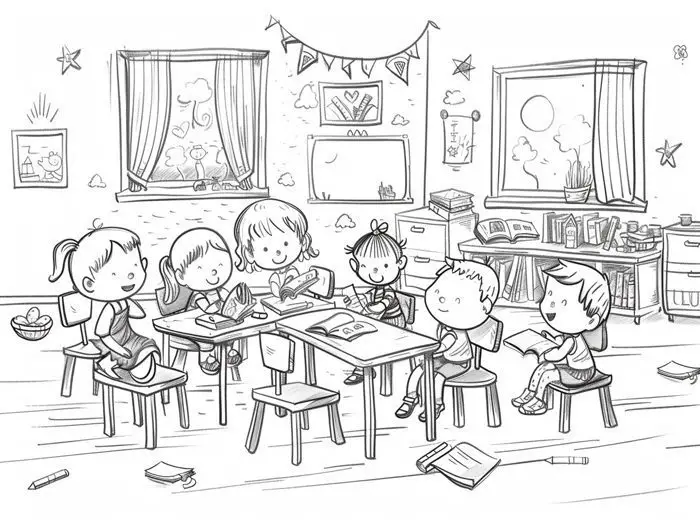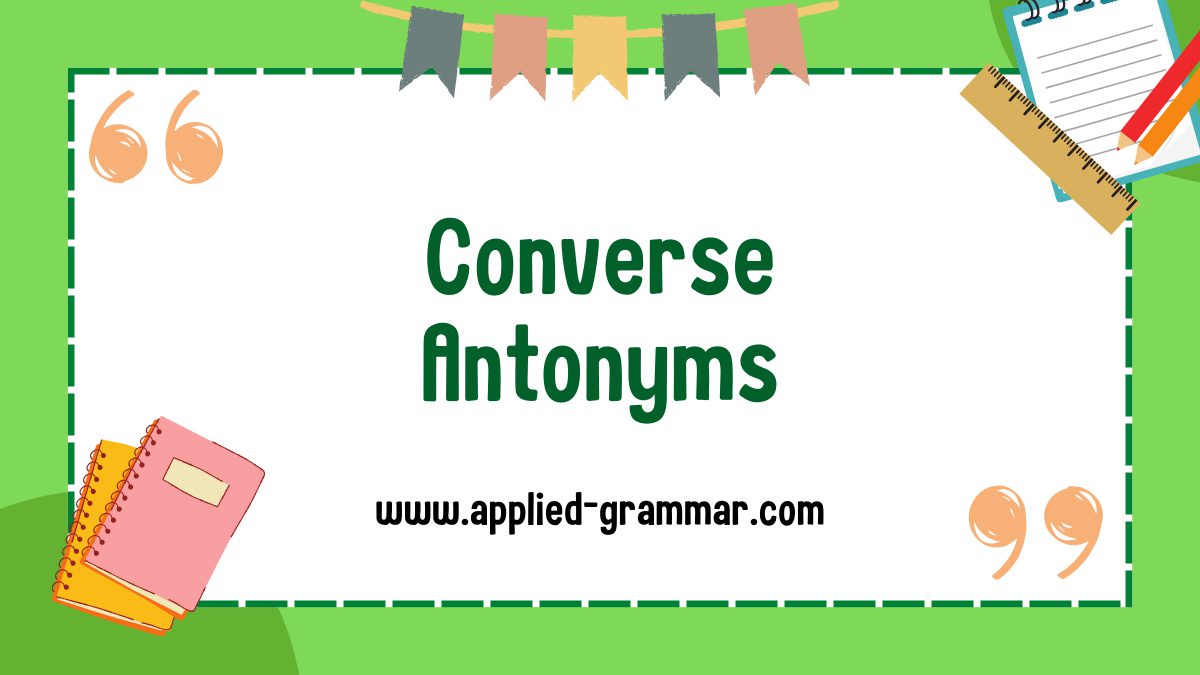Are you looking to enhance your writing skills and expand your vocabulary? One way to achieve this is by familiarizing yourself with antonyms. And today, we’ll be diving into a specific type of antonym called “converse antonyms.”
Converse antonyms are words that have opposite meanings and are related to each other in a specific way. Unlike other types of antonyms, converse antonyms are characterized by a reversal of the relationship between the words. For example, while “parental” refers to the relationship of a parent to a child, its converse antonym “filial” refers to the relationship of a child to a parent.
Understanding converse antonyms not only helps you add variety to your writing but also allows you to create comparisons that are easier to understand. By using converse antonyms effectively, you can enhance the clarity and impact of your writing. So, let’s explore the intriguing area of converse antonyms and discover how they can elevate your linguistic prowess.
Key Takeaways
- Antonyms are words that have opposite meanings and play a vital role in language and communication.
- Converse antonyms are a specific type of antonym that establish a relationship from opposite perspectives.
- Converse antonyms allow for precise and impactful expression in writing by using contrasting words.
- Familiarizing yourself with converse antonyms can enhance your vocabulary and improve your writing skills.
- Incorporating converse antonyms adds depth and richness to your writing, making your message clearer and more engaging.
- Learning converse antonyms enhances vocabulary skills, improves language fluency, and allows for more precise and impactful communication.
What are Antonyms?

Definition of Antonyms
Antonyms are words that have opposite meanings. They are pairs of words that express contrasting concepts. For example, “hot” and “cold” are antonyms, as are “big” and “small” and “stop” and “go.” Antonyms provide a way to describe a concept by highlighting what it is not. They play a vital role in language and communication, helping to convey precise meanings and create effective comparisons.
Importance of Antonyms
Familiarizing yourself with antonyms can greatly enhance your vocabulary and improve your writing skills. Here are some key reasons why antonyms are important:
- Vocabulary Expansion: Learning antonyms allows you to expand your repertoire of words and expressions. By understanding opposite concepts, you can better articulate your thoughts and ideas.
- Variety in Writing: Antonyms provide a way to add variety and depth to your writing. Instead of relying on repetitive language, antonyms allow you to choose words that convey different shades of meaning.
- Clarity in Comparisons: Antonyms help you create clear and concise comparisons. By using contrasting words, you can effectively highlight differences between two things or concepts.
- Precision and Impact: Antonyms allow you to express ideas with precision and make your writing more impactful. Choosing the right antonym can add depth and nuance to your writing, making it more engaging for your audience.
Incorporating antonyms in your writing can elevate the clarity and impact of your message. By understanding and utilizing antonyms, you can improve your linguistic prowess and convey your ideas more effectively. Whether you’re a student, professional, or general reader, exploring the world of antonyms can enhance your language skills and elevate your writing.
Understanding Converse Antonyms
Converse antonyms are an interesting concept that can greatly enhance your writing skills and expand your vocabulary. By understanding converse antonyms, you can improve the clarity and impact of your writing. In this section, we will define converse antonyms and provide examples to help you grasp the concept.

Definition of Converse Antonyms
Converse antonyms are a pair of words that establish a relationship from opposite perspectives. One word describes the subject while the other word describes the object, creating a complementary and contrasting relationship. These antonyms provide a unique way of expressing ideas and can add depth to your writing.
Here are some examples of converse antonyms:
- Employee – Employer
- Parent – Offspring
- Prey – Predator
- Doctor – Patient
As you can see, each pair of words represents a relationship where one word refers to the person or thing that is acting, and the other word refers to the person or thing that is being acted upon. This relationship allows for precise and impactful expression in your writing.
Examples of Converse Antonyms
To further illustrate the concept of converse antonyms, let’s explore some more examples:
- Borrower – Lender
- Teacher – Student
- Landlord – Tenant
- Buyer – Seller
In each of these examples, one word represents the person or entity that is performing an action, while the other word represents the person or entity that is receiving the action. This contrast helps to convey the relationship between the two entities and adds depth to your writing.
Just as understanding antonyms can greatly enhance your vocabulary and writing skills, familiarizing yourself with converse antonyms can take your writing to the next level. Incorporating converse antonyms in your writing allows you to express ideas with precision and impact, making your message clearer and more engaging.
By using converse antonyms, you can create a balance and contrast that adds depth and richness to your writing. So, the next time you want to add a touch of nuance and sophistication to your writing, consider incorporating converse antonyms to elevate your message.
Remember, exploring the world of antonyms and converse antonyms can enhance your language skills and elevate your writing. Whether you are a student, a professional, or a general reader, these insights can be valuable in crafting clear and impactful content.
- Converse antonyms are a pair of words that establish a relationship from opposite perspectives.
- One word describes the subject, while the other word describes the object, creating a complementary and contrasting relationship.
- Converse antonyms allow for precise and impactful expression in writing.
- Examples of converse antonyms include employee – employer, parent – offspring, and prey – predator.
- Familiarizing yourself with converse antonyms can enhance your vocabulary and writing skills.
- Incorporating converse antonyms adds depth and richness to your writing, making your message clearer and more engaging.
Benefits of Learning Converse Antonyms
Converse antonyms, also known as opposites, form an essential part of vocabulary and language skills. Understanding and incorporating converse antonyms into your writing can greatly enhance your communication and elevate your language proficiency. Whether you are a student, a professional, or a general reader, the benefits of learning converse antonyms are numerous.

Improving Vocabulary Skills
One of the significant benefits of learning converse antonyms is the enhancement of your vocabulary skills. Converse antonyms provide you with a diverse range of words to express different concepts. By expanding your knowledge of converse antonyms, you gain access to a broader lexical repertoire, allowing for precise and nuanced communication. This increased vocabulary depth will make your writing more engaging and impactful.
Besides, learning converse antonyms can provide you with alternative ways to describe the same concept. For example, instead of using the word “big,” you can use its converse antonym, “small,” to convey the opposite meaning. This substitution can add variety to your writing and prevent repetitive language use.
Enhancing Language Fluency
Plus to improving your vocabulary, learning converse antonyms can also enhance your language fluency. Understanding converse antonyms allows you to express yourself more accurately by using the appropriate words to convey contrasting ideas. This skill is particularly valuable when expressing complex thoughts or arguments.
By incorporating converse antonyms in your writing, you can effectively highlight the differences and contrasts between concepts. For example, using the converse antonyms “success” and “failure” in a sentence can vividly illustrate the opposing outcomes of a particular situation. This clarity in expression can make your writing more persuasive and convincing.
Summary
Learning converse antonyms offers multiple benefits, such as improving your vocabulary skills and enhancing your language fluency. By familiarizing yourself with converse antonyms, you can enrich your lexical repertoire, leading to more precise and impactful writing. Incorporating converse antonyms into your writing allows for clearer communication of contrasting ideas, making your message more engaging and persuasive.
So, take the time to discover the area of converse antonyms and elevate your language skills, whether you are a student looking to expand your vocabulary, a professional aiming for more impactful communication, or a general reader seeking to enhance your understanding of the English language.
Strategies for Learning Converse Antonyms
To enhance your understanding and mastery of converse antonyms, there are several effective strategies that you can employ. By incorporating these strategies into your learning process, you can expand your vocabulary, improve your writing skills, and enhance your overall language fluency. Let’s explore these strategies in detail:
Reading Widely
A key strategy for learning converse antonyms is to engage in extensive reading across a variety of genres and topics. Reading a wide range of materials exposes you to different contexts and perspectives, allowing you to encounter a diverse range of words and their antonyms. As you come across converse antonyms in your reading, take note of the specific pairs and their meanings. This will help you internalize the relationship between the words and reinforce your understanding of their contrasting meanings. Also, reading widely will also expose you to various sentence structures and writing styles, further enhancing your writing skills.
Using Thesaurus and Wordplay
Another effective strategy for learning converse antonyms is to use resources such as thesauruses and wordplay exercises. Thesauruses are valuable tools that can provide you with synonyms and antonyms for a given word. By exploring the antonyms section, you can discover converse antonyms that you may not have been aware of previously. Wordplay exercises, including puzzles and games, can also be a fun and engaging way to actively practice identifying converse antonyms. These activities challenge your mind to think creatively and actively search for words with opposite meanings, so strengthening your grasp of converse antonyms.
To summarize, incorporating the strategies of reading widely and utilizing resources such as thesauruses and wordplay exercises can greatly enhance your learning of converse antonyms. By exposing yourself to a broad range of texts and actively engaging with language tools, you can expand your vocabulary, improve your writing skills, and develop a deeper understanding of the intricate relationships between words. So, continue to explore new books, articles, and resources, and embrace the playful side of language as you begin on your journey to master converse antonyms.
Common Converse Antonyms

True/False
One of the most common examples of converse antonyms is the pair “true” and “false.” These two words represent opposite perspectives in terms of accuracy or validity. When something is true, it aligns with reality or facts. Conversely, when something is false, it is not true or accurate.
Understanding the relationship between “true” and “false” can greatly enhance your writing skills. It allows you to express opposing viewpoints or contrasting ideas effectively. This can be particularly useful when discussing arguments, theories, or even in storytelling to create tension and conflict.
Happy/Sad
Another pair of converse antonyms that we frequently encounter is “happy” and “sad.” These words represent contrasting emotions. When you are happy, you experience feelings of joy, contentment, and satisfaction. On the other hand, when you are sad, you feel sorrow, grief, or unhappiness.
By mastering the use of “happy” and “sad,” you can add depth and emotional impact to your writing. Whether you are writing a poem, a novel, or a personal essay, understanding how these converse antonyms work together can help you convey a range of feelings and create a more engaging and relatable piece.
Love/Hate
The pair “love” and “hate” is another example of converse antonyms. These words represent opposite emotions towards someone or something. When you love someone or something, you feel affection, adoration, and warmth. Conversely, when you hate someone or something, you feel intense dislike, hostility, or aversion.
Incorporating “love” and “hate” into your writing can bring depth and complexity to your characters or subject matter. Exploring the conflicting emotions of love and hate can add tension, create compelling relationships, and explore the intricacies of human experience.
Understanding and utilizing converse antonyms like “true/false,” “happy/sad,” and “love/hate” can elevate your writing. These contrasting pairs allow you to express opposing ideas, create emotional depth, and engage your readers on a deeper level. By expanding your vocabulary and mastering the use of converse antonyms, you can enhance the clarity, impact, and fluency of your writing.
Conclusion
Understanding converse antonyms can greatly enhance your writing skills and expand your vocabulary. By grasping the concept of pairs of words that establish a relationship from opposite perspectives, you can improve the clarity and impact of your writing. Learning converse antonyms, such as “true/false,” “happy/sad,” and “love/hate,” allows you to add depth and emotional impact to your writing, engaging readers on a deeper level.
By implementing strategies like reading widely and utilizing resources such as thesauruses and wordplay exercises, you can further develop your understanding of converse antonyms. These strategies not only expand your vocabulary, but also improve your writing skills and foster a deeper comprehension of the relationships between words.
Mastering the use of converse antonyms empowers you to create compelling and impactful content. It enables you to effectively convey contrasting perspectives, evoke emotions, and captivate your audience. So, continue to explore and incorporate converse antonyms into your writing, and watch as your language fluency and writing prowess soar to new heights.
